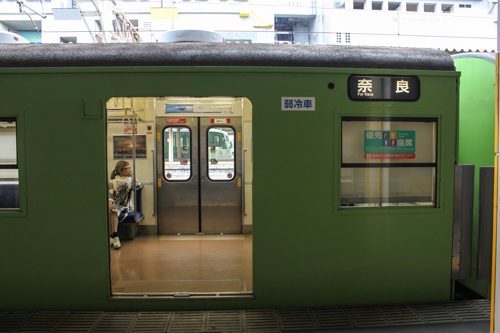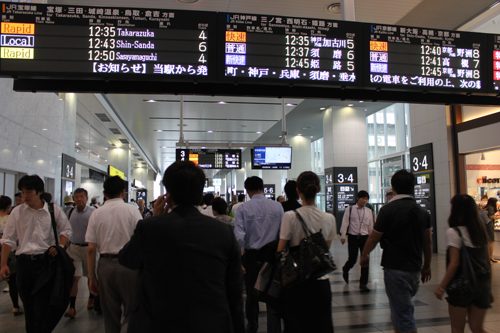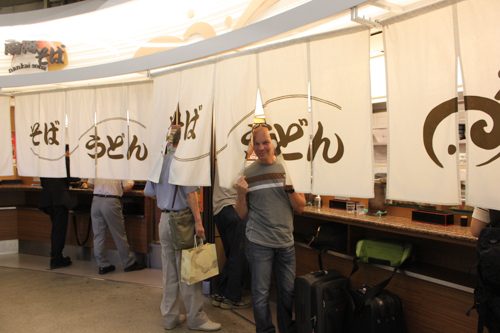Using The Japanese Railway To Get Around
 For us the primary mode of transportation while in Japan was the Japanese railway system; a combination of trains and metros (subways). For people who aren’t train geeks, the differences can be subtle; I’ll just refer to them universally as trains going forward.
For us the primary mode of transportation while in Japan was the Japanese railway system; a combination of trains and metros (subways). For people who aren’t train geeks, the differences can be subtle; I’ll just refer to them universally as trains going forward.
What is more important is the difference between the national Japan Rail (JR) system and private systems. The various companies of JR operate a vast network across the country including the wonderful high-speed Shinkansen. There are also many non-JR or private companies operating trains in popular areas. Why is this important you ask? The JR Pass!
Train travel is not cheap, but foreign nationals can purchase an unlimited JR travel pass voucher before they arrive in Japan and exchange these for JR Passes when they arrive. It is important to note that you cannot purchase these in Japan! The small catch is these are only valid on the JR system. For most travellers this won’t be a problem as JR services most popular destinations including a complete network of trains around Tokyo.
If you are heading off the beaten path, some planning with tell you if it is a private or JR service you need. Details about JR pass options and purchase can be found on the Japan Rail Pass website. For train trip planning on either JR, or private, lines we used the Hyperdia online schedule tool.
One of the things that is awesome about Japan (there are many awesome things about Japan!) is that all train stations are uniquely named. If you know where you are and where you need to go, you just put those locations into the search and pick the date and arrival/departure time. Additional search filters include service type, and JR versus private companies. As expected, results focus on travel efficiency; this may not accommodate a break for lunch if you are a leisure traveller. Good news again – the full schedule for each train on a multi-train routing is accessible and you can pick an earlier or later train and add a break for yourself, which we often did on longer legs. Train stations offer up all kinds of dining options; from stand up noodle stands to full on restaurants and bento box options. It’s worth it to take a break and grab a meal, especially when you know that it’s more than just grotty sandwiches on offer!
Stand Up Noodle Stall in a Japan Railway Station
Old fashion paper maps or online maps will help to identify the name of closest train stations to you or your destination. All of the guesthouses, apartments, ryokans, and minshukus we stayed in provided information about closest train stations and often included information about surrounding attractions and temples and how to get to them using the trains.
Even if you opt for a JR pass you will still need to reserve a seat if you are taking Limited Express or Shinkansen trains as these can fill up more than the local service. Most train stations have staff that can sell you tickets or arrange reservations. The level of spoken English will vary significantly so help yourself and the agent by writing down the information before you get to the window. Important bits; date of travel, train name and number, departure station, departure time, destination station and destination time.
Of course, In the land of vending machines, you can bypass the person and go directly to ticket machines. Each one I encountered had an option for English instructions. Fares are based on the travel zone concept. Think of wider and wider circles on the map centred from where you standing. The fare is the same for all destinations in each circle and there are big boards with the likely stations and fare cost above the ticket machines. Buy a ticket for the fare value you require and you are good to go.
Train ticket vending machine. Not as scary as they look!
Information about which platform your train will be arriving on is available past the gates on large signs posted overhead. The signs will flip between Kanji and English so be patient. On the platform, you will find signage to indicate where your car will stop if you have a reservation. The signage will either be on the ground with directions for lining (queuing) up or suspended overhead; find where your car will stop and line up with the locals.
 Remember the trains are incredible efficient. Some may only stop for less than a minute to allow passengers off and new people on. Be ready when the train arrives at the station; you’ll have to board quickly. If you are a rock star and want special treatment, you’ll have to hire a car.
Remember the trains are incredible efficient. Some may only stop for less than a minute to allow passengers off and new people on. Be ready when the train arrives at the station; you’ll have to board quickly. If you are a rock star and want special treatment, you’ll have to hire a car.
 I love traveling by train. The Japanese railway system takes it to a whole new level; impeccably clean, efficient, and reliable. There is no better way to get around the country.
I love traveling by train. The Japanese railway system takes it to a whole new level; impeccably clean, efficient, and reliable. There is no better way to get around the country.



